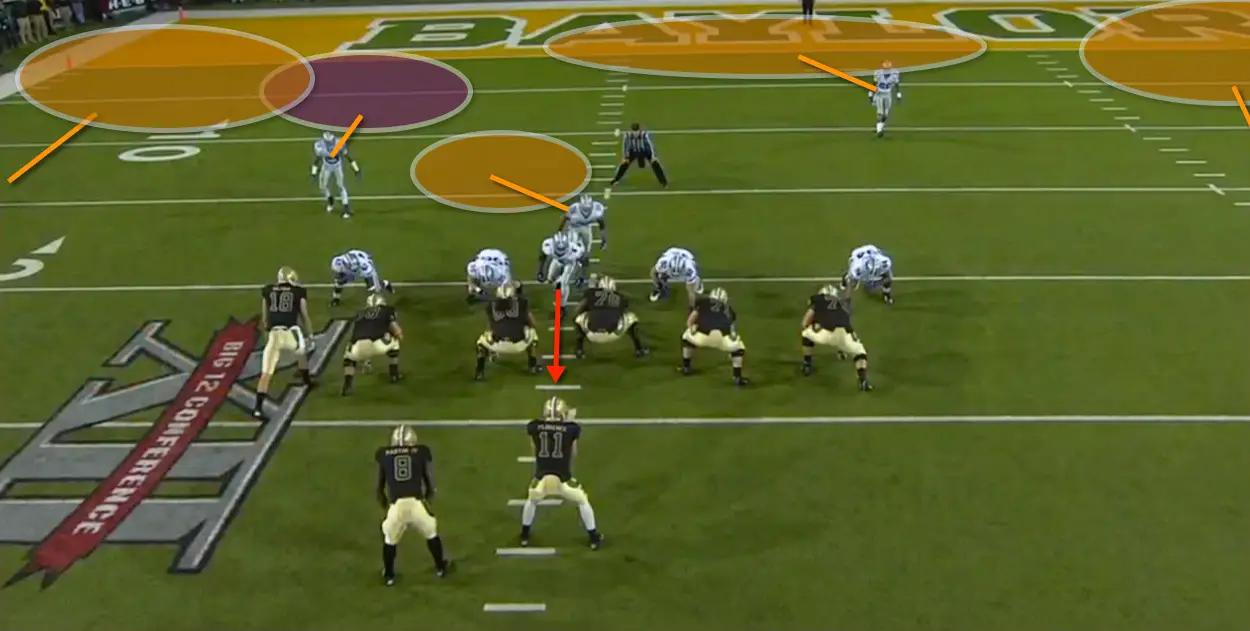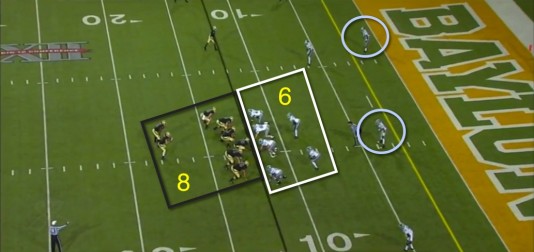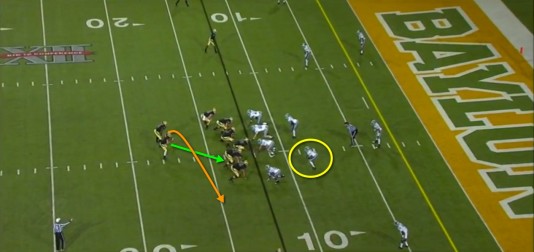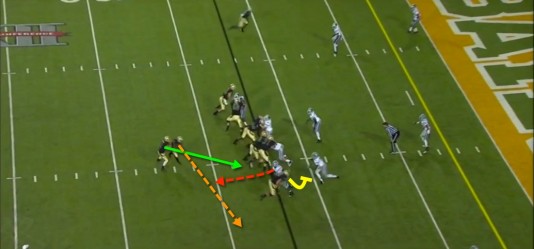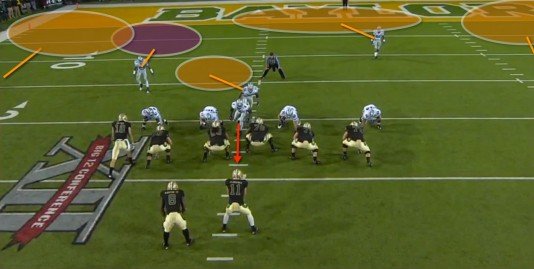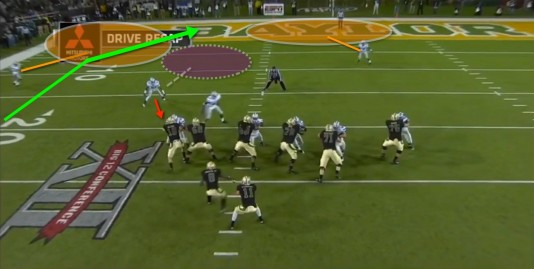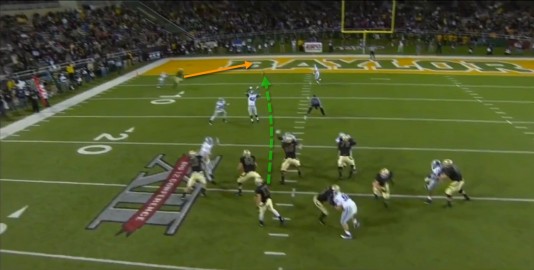Chip Kelly and the Oregon Duck offense have seen countless variations, stunts, and unconventional packages thrown their way over the years. Whether defenses are bringing men out of coverage to account for the run, aligning in creative fashions to confuse the conventional zone blocking schemes, or simply feigning an injury to give the defense a chance to rest, there isn’t much left for Chip Kelly to scheme against.
As you likely know, Kansas State boasts the nation’s most efficient team, and most of that title stems from KSU’s defense; it leads the nation in turnover margin at +22, and is in the top 25 for scoring defenses at 21 points per game, and rushing defense, at 119 yards per game. Kansas State’s turnover margin fell below zero twice this season, once against lowly North Texas, and again against Baylor, the Wildcats’ only loss.
While the high turnover margin and elite rushing defense indicates a successfully aggressive defense, Kansas State will likely avoid stepping out of its comfort zone when it faces Oregon on January 3rd. Evidence suggests that Kansas State will be playing a relatively basic defensive scheme, and allow its disciplined defenders to make tackles in space and prevent explosion plays. Against eleven of their twelve opponents, the scheme worked, and played directly into the hands of the even more efficient Kansas State offense, that churned away at defenses and the game clock. When the Wildcats don’t make mistakes, the scheme works, and can allow the Wildcats to play and beat nearly any team in the country.
But as we’ve seen before this season, Oregon’s offense can conjure many mistakes from their opponents, and while Kansas State will most likely not be making nearly as many as the sometimes porous PAC-12 defenses have this season, containing Oregon’s offense for an entire game is a very hard thing to do, even for the nation’s elite defenses.
Oregon’s offense is a simple numbers game; if there are more defenders in the box than offensive players, Oregon will throw. If there are more offensive players than defensive players, then Oregon will run, and when Kansas State played Baylor this season, the Bears used a similar principal against the Wildcats.
When the spread running game was invented, it was most likely scripted with seven offensive players, and six defenders in the box. Nearly every concept Oregon runs will succeed when given a man advantage at the point of attack, and as shown by the power play diagrammed in the image above, Kansas State will not have much success without devoting more defenders to the running game.
After using quick passes, bubble screens, and short interior runs, Baylor quickly reached the Kansas State red zone early in the game. The Bears used extremely wide formations throughout the game, meaning that the receivers often lined up way outside of the hash marks, isolating the offensive line and defensive front for interior runs. In the picture above, Baylor changes their formation tendencies, and brings in a tight end, or H-back to add a blocker to the offensive front. Still concerned with the bubble screens, Kansas State keeps their original alignment, and gives Baylor a major advantage in the run game, as Baylor now has eight men in the black box, while Kansas State only has six defenders in the white box.
As shown above, Baylor will be running an inverted veer play, which is similar to Oregon’s inside zone play, except the offense will read the playside linebacker (yellow circle), as opposed to a back side defender. Because of the different angles given on the read, the quarterback should take the interior path (green arrow), while the running back will take the exterior path along the orange arrow (the opposite is true on the inside zone play).
At the mesh point in the image above, Kansas State’s defensive lineman immediately disrupts the play, shucks his blocker, and heads towards the ball (red arrow). With a now unblocked defender, Baylor’s quarterback now adjust his read to the crashing lineman that cuts off the interior lane. The proper read would be to give the ball to the running back on the exterior lane.
However, the Baylor quarterback makes the incorrect read, and pulls the ball in the image above. With the two man advantage in the box, however, Baylor is able to pick up both unblocked defenders with no problems (orange circle, and yellow lines), and this allows the quarterback to reach the outside despite making the incorrect read.
Once Baylor’s running game commanded more attention, as shown by the seven man front in the image above, Baylor’s play-action concepts became extremely effective. KSU is running Cover 3, as shown by the three deep orange circles (the outer most defenders are off screen), but will bring a blitz underneath the zone coverage (red arrow). The strong safety is responsible for the run first, then will need to cover a more intermediate zone that defends the space in-between the deep coverages.
As Baylor carries out the play action, the strong safety freezes, and starts to head towards the running back (red arrow above). Once the safety hesitates, the purple zone immediately becomes uncovered, even if the defender is just a few steps behind the play’s progression.
As soon as the receiver breaks for the post (orange arrow above), the ball (green arrow) is placed perfectly in between the deep zones for an easy touchdown.
This particular matchup between Oregon and Kansas State is very similar to the Oregon-Wisconsin matchup from last January. The Badgers boasted efficiency and a stout defense, but lacked the speed and athleticism to run base coverages; thus, they could not avoid neglecting a component of the Oregon offense. Kansas State may have a pair of elite cornerbacks, but the battle for supremacy against Oregon doesn’t usually happen on the outside of the field – it happens inside of the box, where linemen and linebackers are forced to use their athleticism to head off the speedy Oregon skill players. Those KSU shortcomings were especially evident against Baylor, and may be equally evident on January 3rd against Oregon.
If Kansas State allows Oregon to stretch the field and force the Wildcats to take safeties out of the box to defend exterior passes, then Oregon will have no problem running the ball throughout the game.
Related Articles:
Josh is a College Football enthusiast from sunny Southern California. He has written for several self-operated prep sports blogs, as well as multiple SB Nation sites. In High School, Josh played football for four years, and helped create and operate the team’s no-huddle system. Most of Josh’s football knowledge branches from watching College Football his entire life, and is backed up by his first hand experience in both option and spread offenses. Above all, though, he is a proud student at the University of Oregon.
@joshschlichter

